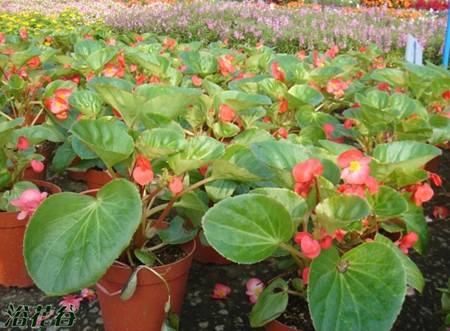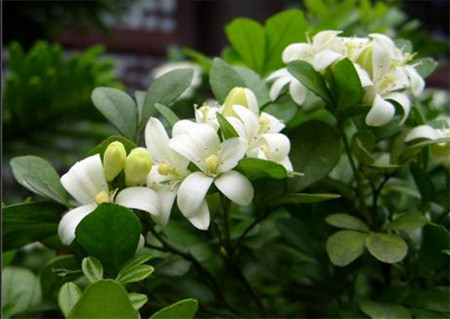Cutting methods of four Seasons Begonia
Four seasons crabapple leaves delicate and bright, flowers in clusters, bright color, four seasons open, is an excellent family potted flowers. Four Seasons Begonia cuttings do not need to be too long. It is recommended that the cuttings be less than 10 centimeters. Too long cuttings will lead to difficulties in water transmission, branch support and decay. In addition to soil insertion, you can also insert water (insert branches in water bottles). The main point of the cultivation of begonia in four seasons is not to get too wet, but it doesn't matter if it's dry. In addition, its sun resistance is also very strong, so there is no need for shade.
The following links should be mastered in its cutting propagation:
1. Cutting time. It is easy for begonia to take root in four seasons, but summer cutting is not recommended. At high temperature, it is often semi-dormant, so it is not easy for cuttings to survive, and it is easy to make cuttings rot, preferably in spring and autumn. You don't have to do any special treatment, it's very simple. Family cutting should be carried out between April and May, when the temperature rises to more than 20 degrees Celsius. At this time, the air humidity is high, the temperature is high, and the management is simple, which is suitable for the rapid rooting of begonia in the four seasons.
2. Selection of cuttings. Cuttings-like selection of robust growth, disease-free tip, the length is about 5mur6 cm, that is, 3-4 nodes, each cuttings with at least 2 buds, cut at 1 cm below the stem node of the cuttings, cut off the leaves near the base, those with flower buds to remove the flower buds, cut into a flat top, cut into a horseshoe shape below, to expand the contact surface with sand, promote rooting, and then cuttings.

3. Cutting substrate. Wash and dry the river sand and place it in a basin. The river sand washed and dried basically achieved the purpose of disinfection, and the sun-dried river sand was beneficial to the daytime sunshine temperature and promote the cuttings section healing and rooting.
4. Cutting and management. Cut in the sand basin with a row spacing of 3 cm × 4 cm. When cutting, we first cut holes in the basin sand with bamboo sticks of the same thickness as the cuttings, and then insert the branches of four seasons crabapple, which do not need to be watered within 2 days after cutting, so as to facilitate the formation of healing tumors on the shear surface. On the fifth day, water with the same temperature as sand is sprayed and poured to the bottom of the basin to see the water flow out. Leave it in the shade and stop watering. A root system of 3-4 cm can grow in about 10 days, then the pot will be placed in the sun and watered according to the weather conditions, and it can be planted in the basin after 6-7 days.
Cutting methods of four Seasons Begonia
[FAQ] Cuttage methods of Malus trifoliata
[expert answers]
Picture: four Seasons Begonia
1. Cutting time. It is easy for begonia to take root in four seasons, but summer cutting is not recommended. At high temperature, it is often semi-dormant, so it is not easy for cuttings to survive, and it is easy to make cuttings rot, preferably in spring and autumn. Generally, you don't have to do special treatment, it's very simple. Family cutting should be carried out from April to May when the temperature rises to more than 20 ℃. At this time, the air humidity is high, the temperature is high, and the management is simple, which is suitable for the rapid rooting of begonia in the four seasons.
2. Selection of cuttings. Cuttings generally choose robust growth, disease-free tip, length of about 5mur6 cm, that is, 3-4 nodes, each cuttings with at least 2 buds, cut 1 cm below the stem node of the cuttings, cut off leaves near the base, those with flower buds to remove flower buds, cut into a flat top shape, cut into horseshoe shape below, to expand the contact surface with sand, promote rooting, and then cut cuttings.
3. Cutting substrate. Wash and dry the river sand and place it in a basin. The river sand washed and dried basically achieved the purpose of disinfection, and the sun-dried river sand was beneficial to the daytime sunshine temperature and promote the cuttings section healing and rooting.
4. Cutting and management. Cut in the sand basin with a row spacing of 3 cm × 4 cm. When cutting, we first cut holes in the basin sand with bamboo sticks of the same thickness as the cuttings, and then insert the branches of four seasons crabapple, which do not need to be watered within 2 days after cutting, so as to facilitate the formation of healing tumors on the shear surface. On the fifth day, spray water with a temperature similar to that of sand, and pour it to the bottom of the basin to see the water flow out. Keep it in the shade and generally no longer water it. About 10 days can grow 3-4 cm root system, then put the pot in the sun, and watering according to the weather conditions, after 6-7 days, it can be planted in the basin.
[editor's summary]
Four seasons begonia, also known as four seasons begonia, clam meat begonia, is the most common species of begonia family plants, because of its beautiful flowers, and four seasons open, is one of the common decorative flowers. There are three propagation methods of four seasons begonia: sowing, cutting and dividing. The first agricultural classic editor introduces the cutting propagation methods of four seasons begonia to you in this article. I hope it will be helpful to you.
The Culture method of four Seasons Begonia
Four seasons crabapple sex like sunshine, slightly shade, afraid of cold, like warm, slightly wet environment and humid soil, but afraid of heat and waterlogging, summer pay attention to shade, ventilation and drainage.
Begonia is propagated by sowing or cutting. The four seasons begonia is easy to receive a large number of seeds, and the germination is very strong, so many seeds are used for propagation. Sow the seeds immediately after harvest, and sow them in a shallow basin from August to September. Pay attention to the fine topsoil. Because the seeds are small and germinate strongly, do not sow too densely. Do not cover the soil after sowing, soak the basin soil, cover it with glass, place it in a semi-shaded place, keep it moist, and seedlings can emerge after a week.
(1) Begonia is not resistant to direct sunlight and rain in summer, so it should be shaded and rainproof. If it is drenched for a long time, it is easy to cause corruption of flower stems and leaves. Winter likes plenty of sunshine, lack of light, then the growth is weak, the plant is slender, the leaf color and flower color become light, the light is too strong, the leaf shrinks, the scorch spot appears, and when the fertilizer is insufficient, the plant is short and the leaf is red.
(2) watering: potted crabapple should be watered after the pot soil is dry. If the pot soil is kept moist for a long time, it is easy to cause root rot to cause blight.
(3) fertilization: the whisker root of the four seasons begonia grows vigorously, and attention should be paid to fertilization management during the growing period. It is suitable to top up the rarefied liquid fertilizer once a week, and the compound fertilizer 150-200ppm is suitable. Watering should be sufficient. After 2 years of cultivation, the growth of the plant gradually weakens and the plant shape is irregular, so it needs to be replaced. In production, it is usually done-annual cultivation. But in horticulture, it can be used as perennial cultivation.
(4) Disease prevention and pest control: Begonia is prone to spot bacteriosis under the condition of high temperature and high humidity. At first, dark brown spots appeared on the leaf surface, and gradually spread to a dark brown rib. The same amount of Bordeaux liquid can be used to prevent the disease before the disease, and attention should be paid to improving the cultivation conditions and management methods. In the early stage of the disease, the diseased leaves should be removed and burned in time to prevent re-spread. Summer is the high incidence period of aphids and red spiders, so it is necessary to control them with pollution-free pesticides in time.

- Prev

The Cuttage method of Corydalis chinensis
The propagation methods of night incense mainly include cutting propagation, striping propagation, ramet propagation and seed breeding, and the most commonly used method is cutting propagation. Cuttage propagation can be carried out except in winter, and it is best to cultivate it in sandy loam soil in a warm and humid climate.
- Next

How to raise the orchid, the cultivation methods and precautions of potted orchid
The orchid, also known as the bird of paradise, has beautiful leaves and strange flowers, just like the head of a crane. In life, many people choose crane orchid when growing flowers, but many of them do not know how to raise it. In this regard, the editor carefully sorted out the culture methods and matters needing attention of potted orchids.
Related
- Fuxing push coffee new agricultural production and marketing class: lack of small-scale processing plants
- Jujube rice field leisure farm deep ploughing Yilan for five years to create a space for organic food and play
- Nongyu Farm-A trial of organic papaya for brave women with advanced technology
- Four points for attention in the prevention and control of diseases and insect pests of edible fungi
- How to add nutrient solution to Edible Fungi
- Is there any good way to control edible fungus mites?
- Open Inoculation Technology of Edible Fungi
- Is there any clever way to use fertilizer for edible fungus in winter?
- What agents are used to kill the pathogens of edible fungi in the mushroom shed?
- Rapid drying of Edible Fungi

